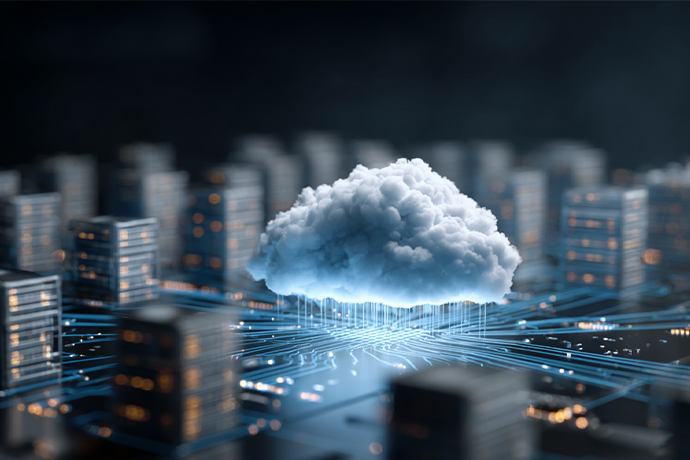Cloud
Nov 13, 2025
Leveraging Hybrid Cloud for AI & High-Performance Workloads
Artificial intelligence and high-performance computing are transforming how the world works. Every company today is becoming a computing company, driven…
Cloud
Published on March 31, 2025

Cloud computing market projections show an expected growth to $864 billion by 2025, with a remarkable 21.5% expansion rate. Gartner predicts that hybrid cloud adoption will reach 90% of organisations by 2027. The digital world continues to evolve through groundbreaking cloud trends that alter how businesses grow and scale. Edge computing combined with 5G now enables immediate data processing. AI integration enhances automation and creates individual-specific experiences. Data centre power usage will likely increase by 160% by 2030. This surge could generate 2.5 billion metric tonnes of carbon dioxide emissions, making eco-friendly cloud computing essential today.
This piece explores the key trends in cloud computing and looks at the most important factors shaping the industry in 2025.
1. Digital transformation: Digital transformation—the integration of digital technologies into all areas of business—is driving rapid cloud adoption. Organizations leveraging cloud computing achieve up to 3x faster time to market and 30% higher operational efficiency. A McKinsey study highlights that companies embracing digital transformation can increase profits by 20%
2. AI driven cloud optimisation: A study initiated by the global SaaS company Ciena has revealed that a majority of IT engineers believe that the use of AI would improve network operational efficiency by 40%. AI-driven cloud optimization is set to significantly shape the cloud market in 2025 by enhancing efficiency, security, and cost management. Here are some of the ways it will define the market. Enhanced security measures driven by AI can analyse vast amounts of data to detect anomalies and potential threats, allowing quicker responses to security incidents and reducing the risk of data breaches. AI also facilitates predictive analytics by analysing historical data to forecast future trends and demands.
Additionally, AI continuously monitors and analyses cloud usage to identify cost-saving opportunities, such as shutting down unused resources or optimizing workloads for cheaper alternatives. Finally, AI improves performance by distributing workloads across the most efficient resources, ensuring high performance and reliability.
3. Efficiency with Edge Computing: 75% of respondents from a survey (initiated by Lumen technologies and Intel) of business leaders, agreed that 5ms Latency is a necessity for applications for edge computing initiatives. And in the modern tech sphere, companies need edge computing to process data in real-time. This speed allows instant data analysis and decision-making, especially when you have healthcare and manufacturing requirements. Edge cloud infrastructure consistently keeps latency under 5ms, while on-premises edge solutions deliver sub-millisecond responses for critical applications.
4. Emerging Technologies: 5G, IoT, and Internet Adoption: The global IoT market is expected to reach $1.1 trillion by 2026, fueled by rapid 5G expansion. 5G networks process data 100 times faster than 4G, enabling ultra-low latency applications and significantly enhancing real-time cloud interactions. Cloud-based remote work solutions have led to a 60% rise in productivity among hybrid workforce models, further solidifying the importance of seamless connectivity in modern business operations.
5. Seamless Deployment with Serverless Computing: Serverless computing is set to revolutionize cloud technology by enhancing developer productivity with advanced tools for debugging, local development, and monitoring, thus accelerating innovation and reducing time-to-market for new applications. It will support seamless deployment across multiple cloud platforms, enabling businesses to optimize performance, reduce costs, and avoid vendor lock-in by leveraging the unique strengths of different providers.
Serverless computing will simplify the deployment and management of AI and machine learning models, facilitating real-time data processing and analytics for actionable business insights. With the proliferation of IoT and edge computing, serverless solutions will become essential for handling massive data volumes, enhancing the scalability and efficiency of cloud-based data analytics crucial for applications like smart cities, autonomous vehicles, and industrial automation.
6. Hybrid & Multi-cloud Strategies: Multi-cloud and hybrid cloud strategies are set to redefine cloud technology, offering businesses greater flexibility, resilience, and efficiency. The adoption of hybrid and multi-cloud environments will continue to grow, with 89% of organizations leveraging multiple cloud providers to avoid vendor lock-in and optimize performance according to Statista.
AI-driven hybrid cloud management will play a crucial role, as AI tools analyse data flows and optimize workload distribution across public and private environments, enhancing cost-effectiveness and performance. Additionally, AI-driven threat detection systems will improve security by identifying vulnerabilities before they escalate.
Edge computing integration will be another key strategy. By processing data closer to the source (e.g., IoT devices) and integrating results with private and public clouds, hybrid cloud enables seamless edge-to-cloud integration.
The adoption of zero trust security models, which demand continuous verification of user identities and device integrity, will protect data across diverse environments. This approach will ensure robust security in hybrid and multi-cloud setups.
Finally, a study by Gartner says that increased cloud spending will be a significant trend. Worldwide end-user spending on public cloud services is forecast to total $723.4 billion in 2025, up from $595.7 billion in 2024.
7. Advancements in Cloud Security: Security remains a top priority in cloud computing, with AI-driven cybersecurity reducing threat detection times by 60%. Secure Access Service Edge (SASE) frameworks are improving security postures, reducing breaches by 45%. As cyber threats continue to evolve, businesses are investing in next-generation security solutions to protect sensitive data and maintain compliance.
8. Introduction of Quantum Computing via the Cloud: Cloud providers are now offering quantum computing services, enabling businesses to solve complex problems beyond the reach of classical computers. Quantum computing can process calculations exponentially faster than traditional systems, making breakthroughs in fields such as cryptography, pharmaceuticals, and logistics. IBM, Google, and AWS have launched quantum computing services, allowing researchers and enterprises to experiment with quantum algorithms via the cloud. As quantum technology matures, businesses will gain access to unparalleled computational power that could revolutionize AI training, financial modeling, and material sciences.
9. Growth of Industry-Specific Cloud Solutions: Tailored cloud services are emerging to meet the unique needs of various industries, ensuring compliance and efficiency. In healthcare, cloud solutions provide secure patient data management and AI-powered diagnostics. Financial institutions benefit from high-performance cloud computing for fraud detection and algorithmic trading. Manufacturing leverages cloud-based IoT integrations to optimize supply chain operations. By aligning cloud services with industry requirements, providers enable businesses to operate with enhanced security, scalability, and regulatory compliance.
10. Sustainability and green cloud computing: Sustainability and green cloud computing are at the forefront of the cloud market, driven by increasing environmental concerns and regulatory pressures. Cloud providers are now offering more transparency into their sustainability practices, with metrics like Power Usage Effectiveness (PUE) and Water Usage Effectiveness (WUE) becoming standard. These metrics allow businesses to make informed decisions based on the environmental impact of their cloud services
Governments and regulatory bodies are imposing stricter sustainability requirements on cloud providers. This includes mandatory reporting on energy usage and carbon emissions, as well as incentives for adopting green technologies. Compliance with regulations like the General Data Protection Regulation (GDPR) ensures that cloud providers operate within legal and ethical boundaries
Environmental sustainability stands as a vital concern in cloud operations. Moving business applications to the cloud can cut energy consumption and carbon emissions by 30% to 90%, depending on the organization size. Small businesses with 100 users see the highest benefits, reducing emissions by up to 90%. Medium-sized companies with 1,000 users achieve 30-60% reductions based on studies from E+E Leader platform.
Data center operators use several strategies to boost sustainability. These include using renewable energy sources for power generation, creating facility designs that improve airflow, setting up water cooling systems to manage heat, and using AI-driven energy management solutions. These measures collectively contribute to more sustainable and efficient cloud operations.
Conclusion:
In conclusion, these trends collectively highlight a dynamic and innovative future for cloud technology, where businesses can leverage advanced tools and strategies to drive growth, efficiency, and sustainability. As we move forward, staying abreast of these developments will be crucial for organizations looking to harness the full potential of cloud technology. Finally, AIOps is revolutionizing IT operations by automating and enhancing monitoring, troubleshooting, and optimization processes, leading to higher performance and reduced operational costs.

Cloud
Nov 13, 2025
Artificial intelligence and high-performance computing are transforming how the world works. Every company today is becoming a computing company, driven…

Cloud
Nov 07, 2025
The cloud promises agility and scale. But for enterprises, it also brings the hard reality of complex management. From provisioning…

Cloud
Aug 29, 2025
Multi-cloud architecture is no longer an emerging trend; it’s an established reality. Recent industry reports show that nearly 90% of…